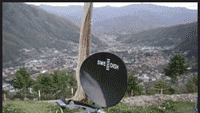Iraq war spurs international broadcasters to new level of satellite newsgathering
Broadcasters and news organizations worldwide turned to SWE-DISH's Fly-Away and IPT suitcase satellite systems during the Iraqi conflict. Some broadcasters used more than five systems at the same time.

The SWE-DISH IPT Suitcase is a single 35kg unit that offers 2Mb/s high-quality video and audio transmission in a small carry-on suitcase-size unit.
Rapid deployment of small broadcast teams with lightweight equipment was the underpinning of war coverage. But smaller didn’t mean less capable. Broadcast journalists in the Gulf demanded the same capability they take for granted in typical ENG settings. Broadcasters’ expectations were to cover all aspects of the story by being everywhere first. The only way to meet that goal was to deliver compact equipment that was highly mobile, easy-to-use, stable and rugged.
More than 1,000 reporters, photographers and television crew members were in the Gulf region, so there was great demand for high-quality gear. While media coverage of the 1991 Gulf War was limited to voice and text, this year’s Iraqi conflict was broadcast live over satellite to all parts of the world. This time Satellite News Gathering (SNG) was used fully maximizing its full potential.
Satellite technology has changed how viewers across the globe are presented with news in their living rooms. A majority of the material broadcast during the war was relayed, unedited as the stories were evolving.
The professional video industry's #1 source for news, trends and product and tech information. Sign up below.
